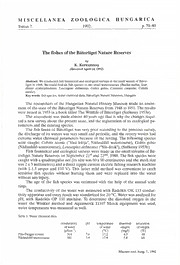
The fishes of the Bátorliget Nature Reserves PDF
Preview The fishes of the Bátorliget Nature Reserves
The fishes of the Bátorliget Nature Reserves by K. Keresztessy (Received April 14, 1992) Abstract: We conducted fish faunistical and ecological surveys in the small waters of Bátor liget in 1988. We could find six fish species in two small watercourses (Rutilus rutilus, Scar- dinius erydirophtalmus, Leucaspius delineatus, Gobio gobio, Carassius carassius, Cobitis taenia). Key words: fish species, water chemical data, Bátorliget Nature Reserves, Hungary. The researchers of the Hungarian Natural History Museum made an assess ment of the state of the Bátorliget Nature Reserves from 1948 to 1951. The results were issued in 1953 in a book titled The Wildlife of Bátorliget (Székessy 1953a). The assessment was made almost 40 years ago that is why the changes requi red a new survey about the present state, and the registration of its ecological pa rameters and the existing species. The fish fauna of Bátorliget was very poor according to the previous survey, the discharge of its waters was very small and periodic, and the rettery waters had extreme water chemical parameters because of the retting. The following species were caught: Cobitis taenia ("Vasi kútja", Nádasdűlő watercourse), Gobio gobio (Nádasdűlő watercourse), Leucaspius delineatus ("Sás-árok"), (Székessy 1953b). Fish faunistical and ecological surveys were made in the small streams of Bá torliget Nature Reserves on September 21st and 22nd, 1988. The fish species were caught with a quadrangular net (its size was 60 x 90 centimetres and the mesh size was 2x3 millimetres) and a direct ripple current electric fishing research machine (with 1-1.5 amper and 110 V). This latter mild method was convenient to catch sensitive fish species without hurting them and were replaced into the water without any injury. The age of the fish species was estimated with the help of the annual scale rings. The conductivity of the water was measured with Radelkis OK 113 conduc tivity apparatus and every result was standarized for 20 °C. Water was analysed for pH, with Radelkis OP 110 machine. To determine the dissolved oxygen in the water the Winkler method and Aquamerck 11107 Merck equipment was used, water temperature was measured as well. Table 1. Water chemical data conductivity pll temperature dissolved saturation of water of water oxygen of oxygen (wScm"1) (°C) (mg/1) (%) Pilis-Pirigye stream 314 7.0 17.2 4.3 48 Nádasdűlő watercourse 3S1 7.9 17.9 5.8 65 This project was supported by the Ministry of Environment. We could catch the following fishes: Rutilus rutilus (Linnaeus, 1758) Scardinius erythophthalmus (Linnaeus, 1758) Leucaspius delineatus (Heckel, 1843) Gobio gobio (Linnaeus, 1758) Carassius carassius (Linnaeus, 1758) Cobitis taenia (Linnaeus, 1758) We could only find fishes in two small watercourses; in the Pilis-Pirigye stream and in the Nádasdűlő watercourse. To sum it up, the Nature Reserves is poor both in fish species and in number of individuals. Table 2. The examined specimens and their estimated ages Pilis-Pirigye stream Nádasdúlő watercourse Rutilus rutilus 2 specimens, 2-3 years Scardinius eryth. 1 specimen, 2 years Leucaspius delineatus 5 specimens, 3 years 3 specimens, 2-3 years Gobio gobio 1 specimen, 3 years Carassius carassius 1 specimen, 1 years 1 specimen, 2 years Cobitis taenia 2 specimens, 3 years 3 specimens, 3-4 years Forty years ago Gobio gobio, Cobitis taenia, Leucaspius delineatus were found in the waters of Bátorliget. During our research we caught these three species and in addition we found three other species, such as Rutilus rutilus, Scardinius eryth- rophthalmus, Carassius carassius (but they occured only in limited numbers). References Székessy, V. (ed.) (1953a): Bátorliget élővilága (Die Tier- und Pflanzenwelt des Naturschutzgebietes von Bátorliget und seiner Umgebung). - Akadémiai Kiadó, Budapest, pp. 486. Székessy, V (1953b): - Bátorliget hal-faunája. Pisces - In: Székessy, V. (ed.): Bátorliget élővilága. Aka démiai Kiadó, Budapest, p. 430. Author's address: Dr. Katalin Keresztessy Institute of Animal Husbandry University of Agricultural Sciences H-2103 Gödöllő Hungary
